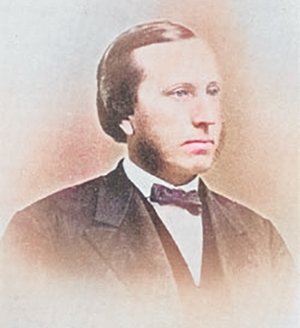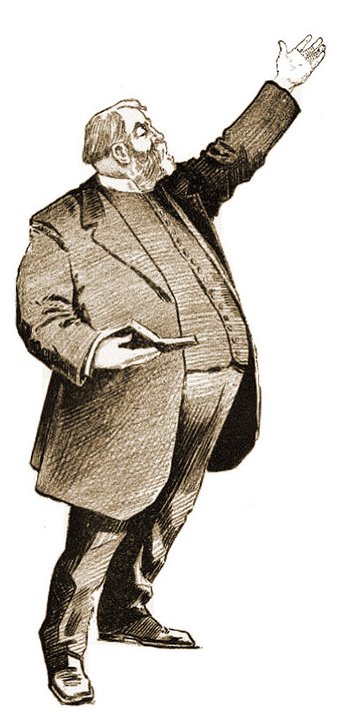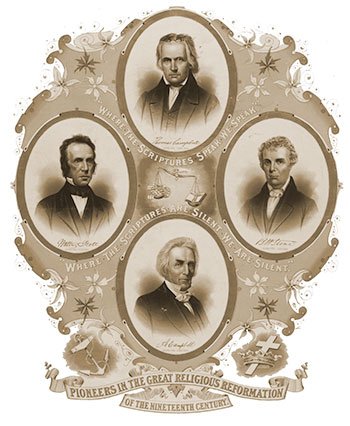The 1857 Anson Street Revival

John Girardeau
The Anson Street Revival of 1857, which occurred in the summer, preceded the Laymen’s Prayer Revival also known as the Businessmen’s Revival which began in the fall of 1857. It stands as a significant event in the religious landscape of the United States, particularly in the South. This revival, which took place at the Anson Street Presbyterian Church in Charleston, South Carolina, ignited a spark of spiritual awakening that spread throughout the city and beyond. This article delves into the history of this remarkable event, exploring its origins, key figures, impact, and lasting legacy.
The Religious Climate in Antebellum Charleston
Charleston in the mid-19th century was a city of diverse religious beliefs. The Methodist Church held the largest following, followed by Baptists, Presbyterians, Episcopalians, and various other denominations, including the Roman Catholic Church, which was growing due to an influx of immigrants from Europe. This diverse religious landscape, combined with the social and economic tensions of the time, played a crucial role in shaping the Anson Street Revival.
A City Primed for Revival
The Anson Street Revival was not an isolated incident. It emerged from a growing trend of prayer meetings in New York and Boston in the years leading up to 1857. These meetings, often initiated by laypeople, reflected a yearning for spiritual renewal and a desire to see God move in a powerful way. The renowned preacher Charles Finney played a significant role in this pre-revival period, holding meetings in various cities that led to a surge in conversions. In 1851, his meetings in Syracuse reportedly resulted in 100,000 conversions. This growing fervour for spiritual awakening set the stage for the events that would unfold in Charleston.
Charles Finney played a significant role in this pre-revival period, holding meetings in various cities that led to a surge in conversions. In 1851, his meetings in Syracuse reportedly resulted in 100,000 conversions.
The Panic of 1857, a financial crisis that gripped the nation, further fuelled this sense of urgency and uncertainty, driving people to seek solace and guidance in faith. This economic turmoil created a backdrop of anxiety and introspection, making the message of hope and redemption offered by the revival all the more appealing.
Dr. John L. Girardeau: A Shepherd Leading His Flock
Dr. John L. Girardeau, the pastor of Anson Street Presbyterian Church, played a pivotal role in the revival. A man of deep faith and conviction, he was known for his passionate preaching and his commitment to serving both black and white members of his congregation. His leadership and spiritual sensitivity were instrumental in guiding the revival and fostering an atmosphere of unity and spiritual hunger.
The Spark that Ignited the Flame
The Anson Street Presbyterian Church was unique for its time, as it consisted of both black and white members. This interracial congregation, a rarity in the racially divided South, foreshadowed the unifying power of the revival. In the summer of 1857, Dr. Girardeau, sensing a spiritual hunger among his congregation, called them to pray for revival. They began holding prayer meetings in the Consistory of the church, “petitioning God to send a spiritual awakening”. These meetings were characterized by fervent prayer and a deep longing for the outpouring of the Holy Spirit.
One evening, during a prayer meeting, Dr. Girardeau experienced a profound spiritual encounter. He described it as “a surge of electricity” that struck his head and filled his entire body. He sensed the presence of the Holy Spirit in a powerful way and declared, “The Holy Spirit has come”. This marked the beginning of the Anson Street Revival.
One evening, during a prayer meeting, Dr. Girardeau experienced a profound spiritual encounter. He described it as “a surge of electricity” that struck his head and filled his entire body. He sensed the presence of the Holy Spirit in a powerful way and declared, “The Holy Spirit has come”. This marked the beginning of the Anson Street Revival.
The Revival Unfolds
Following Dr. Girardeau’s experience, the prayer meetings at Anson Street Presbyterian Church intensified. The congregation continued to meet every evening, and the crowds grew rapidly, reaching 1,500 to 2,000 people. The revival lasted for eight weeks, with Dr. Girardeau preaching the Gospel each night.
The revival unfolded in distinct phases. It began with a period of earnest prayer and seeking God, culminating in Dr. Girardeau’s profound spiritual experience. This ignited a spark that spread throughout the congregation and beyond, drawing people from all walks of life to the nightly meetings. The revival was characterized by a sense of urgency, with participants experiencing deep conviction of sin and a hunger for spiritual renewal.
The impact of the revival was undeniable. Many people experienced conversions and spiritual awakenings. Churches throughout Charleston saw a surge in attendance and new members. One church in Beaufort, South Carolina, reported over 400 new members in just three days. The revival transformed the spiritual atmosphere of Charleston, creating a sense of unity and purpose among believers.
Manifestations of the Holy Spirit
The Anson Street Revival was marked by powerful manifestations of the Holy Spirit. Participants reported feeling a tangible sense of God’s presence, and many experienced deep conviction of sin, leading to repentance and a renewed commitment to Christ. The revival also fostered a spirit of unity and generosity, with people from all walks of life coming together to pray and support one another.
One of the notable aspects of the revival was the sense of collective prayer and shared spiritual experience. Participants described feeling a surge of emotion and a deep connection with God and with each other. This sense of unity transcended social and racial barriers, bringing together a diverse group of people in a common pursuit of spiritual renewal.
Personal Testimonies
The Anson Street Revival left a lasting impact on the lives of many individuals. Participants recounted experiences of profound spiritual transformation, describing a newfound sense of purpose and joy. One participant shared, “I felt as if a surge of electricity struck my head and filled my entire being”, echoing Dr. Girardeau’s own experience. This sense of the Holy Spirit’s presence was a common thread in many personal testimonies, highlighting the revival’s power to touch individuals deeply.
One participant shared, “I felt as if a surge of electricity struck my head and filled my entire being”, echoing Dr. Girardeau’s own experience. This sense of the Holy Spirit’s presence was a common thread in many personal testimonies, highlighting the revival’s power to touch individuals deeply.
The revival also had a profound effect on those who witnessed its impact. Observers noted a change in the overall atmosphere of the city, with a decrease in crime and an increase in acts of charity and compassion. This suggests that the revival not only transformed individual lives but also had a ripple effect on the wider community.
Lasting Impact and Legacy
The Anson Street Revival had a profound impact on Charleston and beyond. It led to a significant increase in church membership and sparked a renewed interest in spiritual matters. The revival also had a social impact, as it fostered a spirit of compassion and service, leading to the establishment of various charitable initiatives, including hospitals, schools, and programs to address social needs.
The revival’s impact on Charleston was so significant that it changed the makeup of the city. This led to criticism and even threats against the revival leaders, particularly Dr. Girardeau, who was accused of teaching slaves to read, which was against the law at the time. This opposition highlights the transformative power of the revival and its challenge to the existing social order.
The legacy of the Anson Street Revival continues to inspire believers today. It serves as a reminder of the power of prayer and the transformative potential of spiritual awakening. The revival’s emphasis on unity, humility, and dependence on the Holy Spirit provides valuable lessons for churches seeking to experience revival in their own communities.
Contemporary Revivals
The Anson Street Revival was part of a larger movement of religious awakenings that swept across the United States and other parts of the world in the mid-19th century. This period, known as the Third Great Awakening, was characterized by a decline in religious life followed by a surge in prayer movements and revivals. In the years leading up to the Anson Street Revival, similar prayer movements were already taking place in Ontario, Canada, with reports of increased church membership and spiritual fervour.
These revivals, often characterized by fervent prayer and a focus on personal conversion, had a profound impact on society, leading to social reforms and a renewed emphasis on religious values. The Anson Street Revival, with its unique interracial dimension, stands out as a powerful example of the unifying and transformative potential of these awakenings.
Lessons Learned
The Anson Street Revival offers several key takeaways that remain relevant today:
The Importance of Prayer: The revival began with a call to prayer and was sustained by the fervent prayers of believers. This highlights the vital role of prayer in seeking God’s intervention and experiencing spiritual awakening.
The Power of Unity: The Anson Street Presbyterian Church was a diverse congregation that came together in unity to seek God. This demonstrates the power of unity in overcoming divisions and experiencing the fullness of God’s presence.
The Necessity of Humility: Dr. Girardeau’s willingness to wait on the Holy Spirit and his refusal to commence preaching services until he sensed God’s leading underscore the importance of humility and dependence on God in seeking revival.
Timeline of the Anson Street Revival
| Date | Event |
|---|---|
| Summer 1857 | Dr. John L. Girardeau calls his congregation to pray for revival at Anson Street Presbyterian Church. |
| Summer 1857 | Prayer meetings begin at Anson Street Presbyterian Church. |
| Summer 1857 | Dr. Girardeau experiences a powerful manifestation of the Holy Spirit during a prayer meeting. |
| Summer 1857 | The Anson Street Revival begins, with nightly meetings and fervent prayer. |
| Summer 1857 | Crowds at the revival meetings grow rapidly, reaching 1,500 to 2,000 people. |
| Summer 1857 | The revival lasts for eight weeks, with Dr. Girardeau preaching the Gospel each night. |
| Summer 1857 | Many people experience conversions and spiritual awakenings. |
| Summer 1857 | Churches throughout Charleston see a surge in attendance and new members. |
| April 1859 | The Anson Street Presbyterian Church moves to a new building and is renamed Zion Presbyterian Church. |
Conclusion
The Anson Street Revival stands as a testament to the transformative power of the Holy Spirit and the enduring legacy of faith. It emerged during a time of social and economic upheaval, offering a message of hope and unity that resonated deeply with the people of Charleston. The revival’s impact extended beyond the walls of the church, influencing the social fabric of the city and inspiring similar awakenings across the nation.
The Anson Street Revival serves as an inspiration for believers today, reminding us of the importance of prayer, unity, and humility in seeking God’s presence and experiencing revival in our own time. Its legacy continues to challenge us to embrace diversity, to seek spiritual renewal, and to live out our faith in ways that transform our communities and our world.
Sources
The 1857-1862 Revival When God comes – Heritage Christian Church
https://heritagecc.org/wp-content/uploads/2019/01/1860-Revival-final.pdf
Jeremiah Lanphier – Wikipedia
https://en.wikipedia.org/wiki/Jeremiah_Lanphier
AMERICA’S THIRD GREAT AWAKENING – End Time Mysteries
https://endtimemysteries.com/2021/01/25/americas-third-great-awakening-2/
The Great Awakening of 1857-1858
https://eagleworldwide.com/data/GreatAwakening.pdf
The Layman’s Prayer Revival 1857-58
https://bibleprayerfellowship.wordpress.com/2017/02/20/the-laymans-prayer-revival-1857-58/
John L. Girardeau biography
https://www.pcahistory.org/HCLibrary/periodicals/spr/bios/girardeau.html



